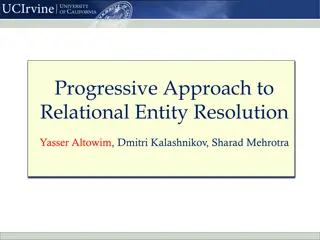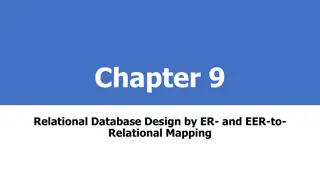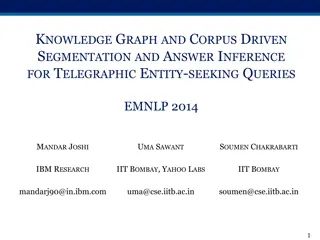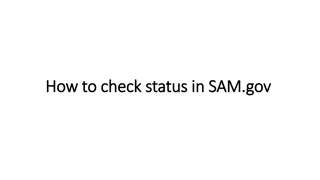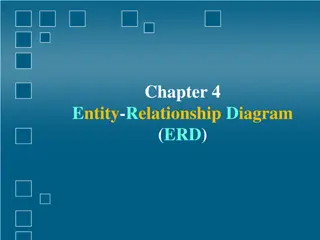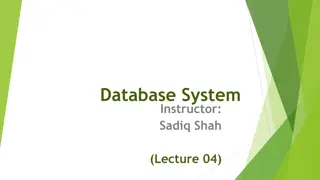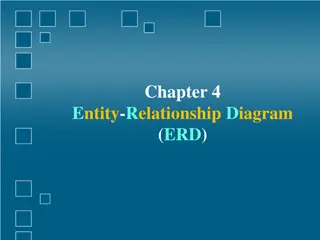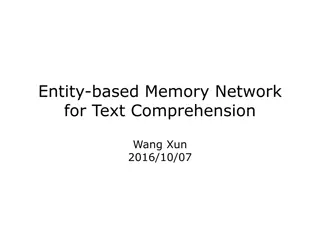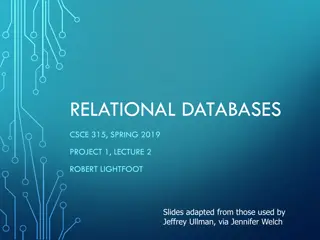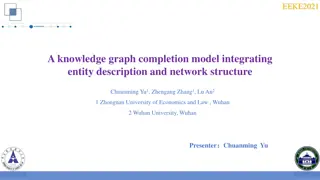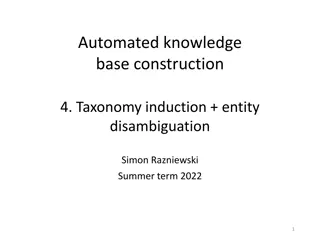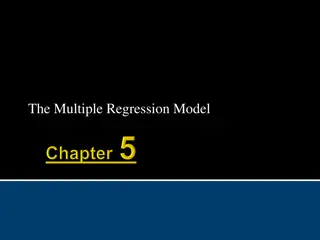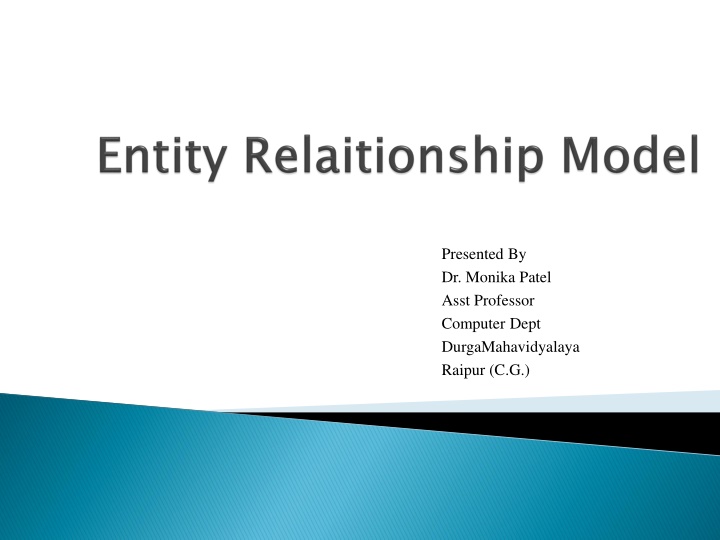
The ER Data Model for Effective Database Design
The ER data model simplifies database design by representing the logical structure of a database through entity sets, relationship sets, and attributes. Entities, relationships, and attributes play essential roles in creating a conceptual schema. Explore how entities, relationships, and attributes are interconnected and how the ER model aids in database visualization and organization.
Download Presentation

Please find below an Image/Link to download the presentation.
The content on the website is provided AS IS for your information and personal use only. It may not be sold, licensed, or shared on other websites without obtaining consent from the author. If you encounter any issues during the download, it is possible that the publisher has removed the file from their server.
You are allowed to download the files provided on this website for personal or commercial use, subject to the condition that they are used lawfully. All files are the property of their respective owners.
The content on the website is provided AS IS for your information and personal use only. It may not be sold, licensed, or shared on other websites without obtaining consent from the author.
E N D
Presentation Transcript
Presented By Dr. Monika Patel Asst Professor Computer Dept DurgaMahavidyalaya Raipur (C.G.)
The ER data mode was developed to facilitate database design by allowing specification of an enterprise schema that represents the overall logical structure of a database. The ER model is very useful in mapping the meanings and interactions of real-world enterprises onto a conceptual schema. Because of this usefulness, many database-design tools draw on concepts from the ER model. The ER data model employs three basic concepts: Entity sets, Relationship sets, Attributes. The ER model also has an associated diagrammatic representation, the ER diagram, which can express the overall logical structure of a database graphically.
An entity is an object that exists and is distinguishable from other objects. Example: specific person, company, event, plant An entity set is a set of entities of the same type that share the same properties. Example: set of all persons, companies, trees, holidays An entity is represented by a set of attributes; i.e., descriptive properties possessed by all members of an entity set. Example: instructor = (ID, name, course= (course_id, title, credits) A subset of the attributes form a primary key of the entity set; i.e., uniquely identifiying each member of the set. ) street, city, salary
instructor_ID instructor_name student-ID student_name
Arelationship is an association among several entities. Example: 44553 (Peltier) advisor 22222(Einstein) student entity relationship set instructor entity A relationship set is a mathematical relation among n 2 entities, each taken from entity sets {(e1, e2, en) | e1 E1, e2 E2, , en En} where (e1, e2, , en) is a relationship Example: (44553,22222) advisor
An attribute can also be associated with a relationship set. For instance, the advisor relationship set between entity sets instructor and student may have the attribute date which tracks when the student started being associated with the advisor
Binary relationship involve two entity sets (or degree two). most relationship sets in a database system are binary. Relationships between more than two entity sets are rare. Most relationships are binary. (More on this later.) Example: students work on research projects under the guidance of an instructor. relationship proj_guide is a ternary relationship between instructor, student, and project
Express the number of entities to which another entity can be associated via a relationship set. Most useful in describing binary relationship sets. For a binary relationship set the mapping cardinality must be one of the following types: One to one One to many Many to one Many to many
One to one One to many Note: Some elements in A and B may not be mapped to any elements in the other set
One to one One to many Many to many Many to one Note: Some elements in A and B may not be mapped to any elements in the other set
Attribute types: Simple and composite attributes. Single-valued and multivalued attributes Example: multivalued attribute: phone_numbers Derived attributes Can be computed from other attributes Example: age, given date_of_birth Domain the set of permitted values for each attribute
Attribute types: Simple Single Example: multivalued attribute: phone_numbers Derived Can be computed from other attributes Example: age, given date_of_birth Domain each attribute Simple and composite Single- -valued composite attributes. valued and multivalued multivalued attributes Derived attributes Domain the set of permitted values for
Suppose we have entity sets: instructor, with attributes: ID, name, dept_name, salary department, with attributes: dept_name, building, budget We model the fact that each instructor has an associated departmentusing a relationship set inst_dept The attribute dept_name appears in both entity sets. Since it is the primary key for the entity set department, it replicates information present in the relationship and is therefore redundant in the entity set instructor and needs to be removed.


